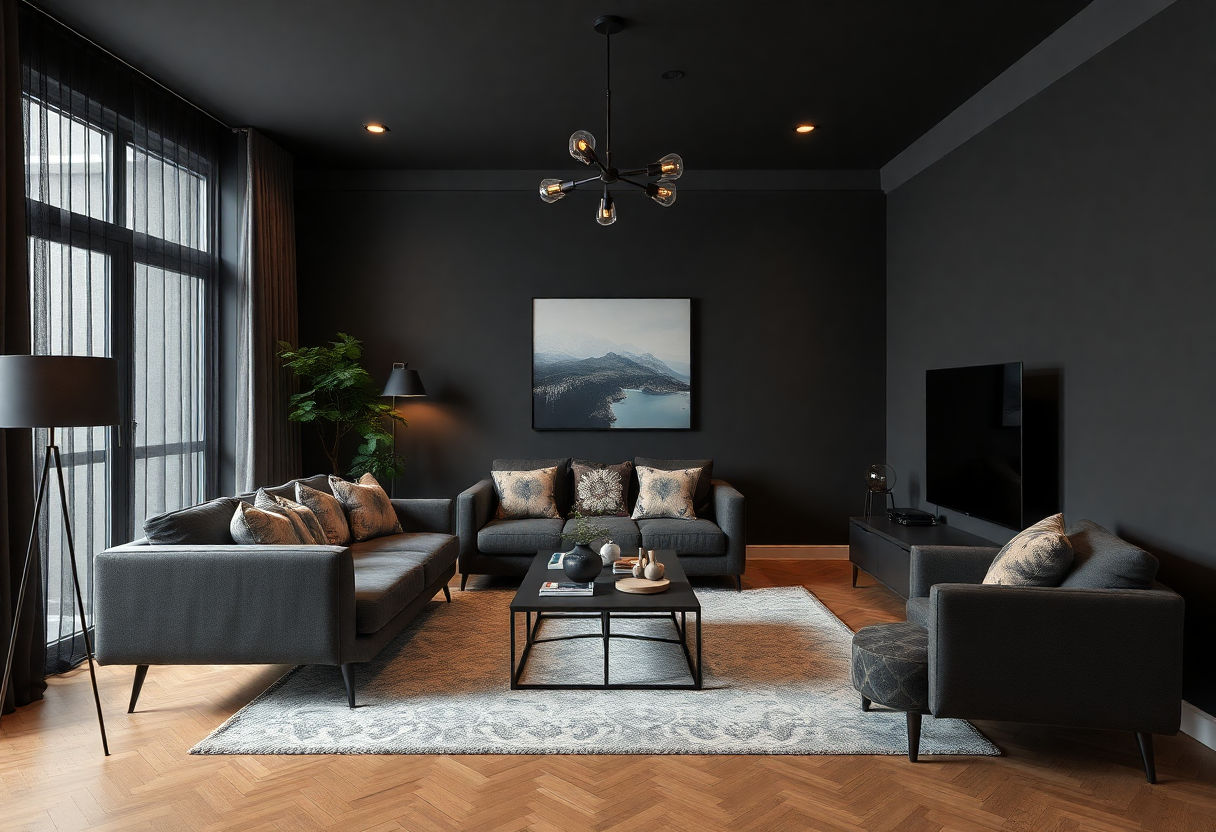Exploring the dark apartment aesthetic unveils a world of sophistication and modern elegance, charming those who appreciate contemporary interior design. This article delves into the increasing allure of dark aesthetics, offering insights on choosing the perfect color palette and enhancing spaces with dark furnishings. It also highlights the art of effective lighting and the clever use of textures and materials to add depth and warmth. By balancing these elements with vibrant accents and thoughtful decor, one can craft a space that’s both stylish and inviting. Discover real-life inspirations that reaffirm the enduring appeal of this timeless design approach.
Key Takeaways
- A dark apartment aesthetic offers a sophisticated and unique charm that is gaining popularity in urban environments.
- Selecting the right color palette is crucial to achieving a balanced and inviting dark-themed living space.
- Integrating dark furniture can enhance elegance and complement the apartment’s overall aesthetic.
- Thoughtful lighting strategies play a vital role in highlighting the beauty of dark interiors and can create a harmonious ambiance.
- Using diverse textures and materials can add depth to dark spaces, making them feel cozy and welcoming.
The Appeal of Dark Aesthetics
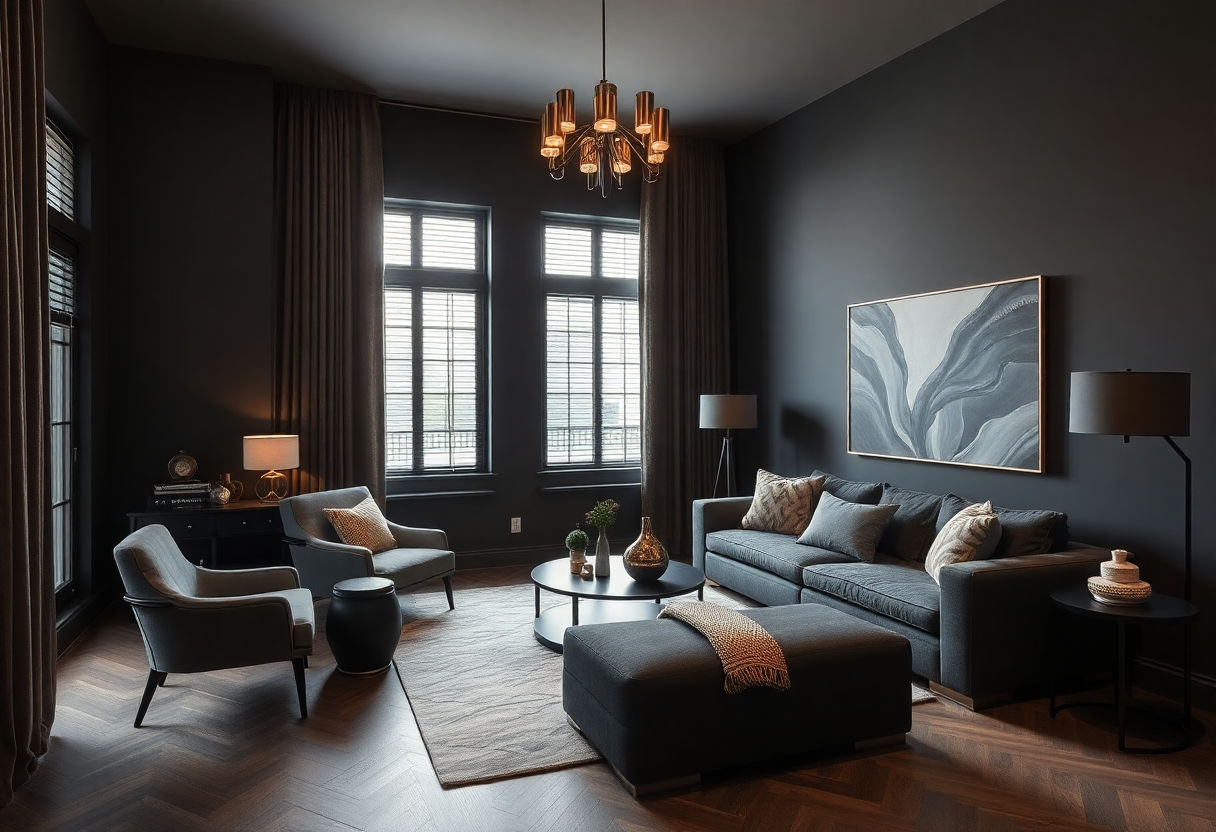
The increasing popularity of dark aesthetics in urban living can be attributed to their ability to convey both elegance and individuality. Urban dwellers often seek a retreat from the bustling external environment, and dark interiors provide a serene and intimate setting that counterbalances the outside world. The dark aesthetic’s unique appeal lies in its versatility and the potential to create an atmosphere of sophistication and artistry.
Dark color schemes bring an element of mystery and depth to living spaces, allowing residents to express modernity and style without the clutter of brighter colors. This approach to interior design embraces a sense of polished minimalism, where every element is carefully curated to enhance the overall ambiance.
In addition, dark aesthetics are adaptable to various design styles, from industrial lofts with exposed brick and metal to sleek, minimalist studios featuring clean lines and high-gloss finishes. This flexibility makes them particularly appealing to urban residents who value both trendiness and functionality in limited spaces.
The allure of dark aesthetics is also enhanced by the emotional responses they evoke. According to design experts, dark hues can give a sense of security and exclusivity, making the home feel like a personal haven. Furthermore, as sustainability becomes increasingly important, dark aesthetics offer opportunities to incorporate eco-friendly materials and technologies seamlessly.
In summary, the rising appeal of dark aesthetics in urban environments is tied to their ability to create distinctive, stylish, and tranquil living spaces that reflect personal taste while maintaining an air of timeless elegance.
Choosing the Right Color Palette
When it comes to creating a captivating dark apartment aesthetic, selecting the right color palette is crucial. The palette serves as the foundation for your design, influencing the mood and perception of space.
First, consider the primary base color. Deep, rich tones such as charcoal gray, navy blue, or forest green can establish a sophisticated and cozy atmosphere. These colors absorb light, making spaces feel intimate and inviting. Complement these hues with secondary shades to add balance and prevent the room from feeling too enclosed. For instance, include subtle tones like soft grays or muted blues, which can offer contrast without breaking the dark theme.
To add depth and interest, incorporate accent colors. Metallics, such as gold, bronze, or silver, provide a touch of luxury and can enhance the elegance of the space. Additionally, incorporating natural tones like ochre or terracotta can introduce warmth, preventing the design from becoming too cold. Consider these color accents in textiles, artwork, or small decor items.
To effectively use these colors, apply them strategically:
- Wall Treatments: Use the base color for accent walls or all-over coverage to create a dramatic effect.
- Furniture and Fabrics: Choose upholstery in secondary shades for sofas or cushions to create contrast.
- Decor: Metallic or warm-toned accessories can be sprinkled throughout to highlight specific areas.
By thoughtfully selecting and applying colors, you can craft a dark-themed apartment that is both stylish and inviting.
Enhancing Space with Dark Furniture
Incorporating dark furniture into apartment interiors can significantly transform a space, offering a distinctive blend of sophistication and style. Choosing pieces that are both functional and aesthetically pleasing holds the potential to enhance the space remarkably. Here are some key suggestions for leveraging dark furniture to maximize aesthetics:
-
Contrast and Balance: Integrating dark furniture seamlessly benefits from balancing it with lighter elements. This contrast not only adds visual interest but also prevents the space from feeling too heavy or claustrophobic. For instance, a charcoal sofa paired with light-colored throw pillows can create a striking yet harmonious look.
-
Emphasizing Space: Dark furniture, when strategically placed, can emphasize the true dimensions of a room. Opt for streamlined designs to maintain an open and airy feel. A sleek black coffee table can serve as a centerpiece without overwhelming smaller spaces.
-
Material Importance: The materials used in dark furniture can facilitate depth and texture. Expensive woods like mahogany or ebony, with intricate grains, can add a layer of luxury. For those preferring more modern touches, matte black metal or polished dark glass can introduce an industrial chic vibe.
-
Complementary Accents: Adding metallic or glass accents can further enhance the elegance of dark furniture. Elements such as brass lamp fixtures or mirrored surfaces not only reflect light but also create an opulent ambiance.
Choosing the right dark furniture and effectively incorporating it into the space can dramatically elevate the appeal of a dark-themed apartment, striking a perfect balance between elegance and modernity.
Lighting Techniques for Dark Spaces
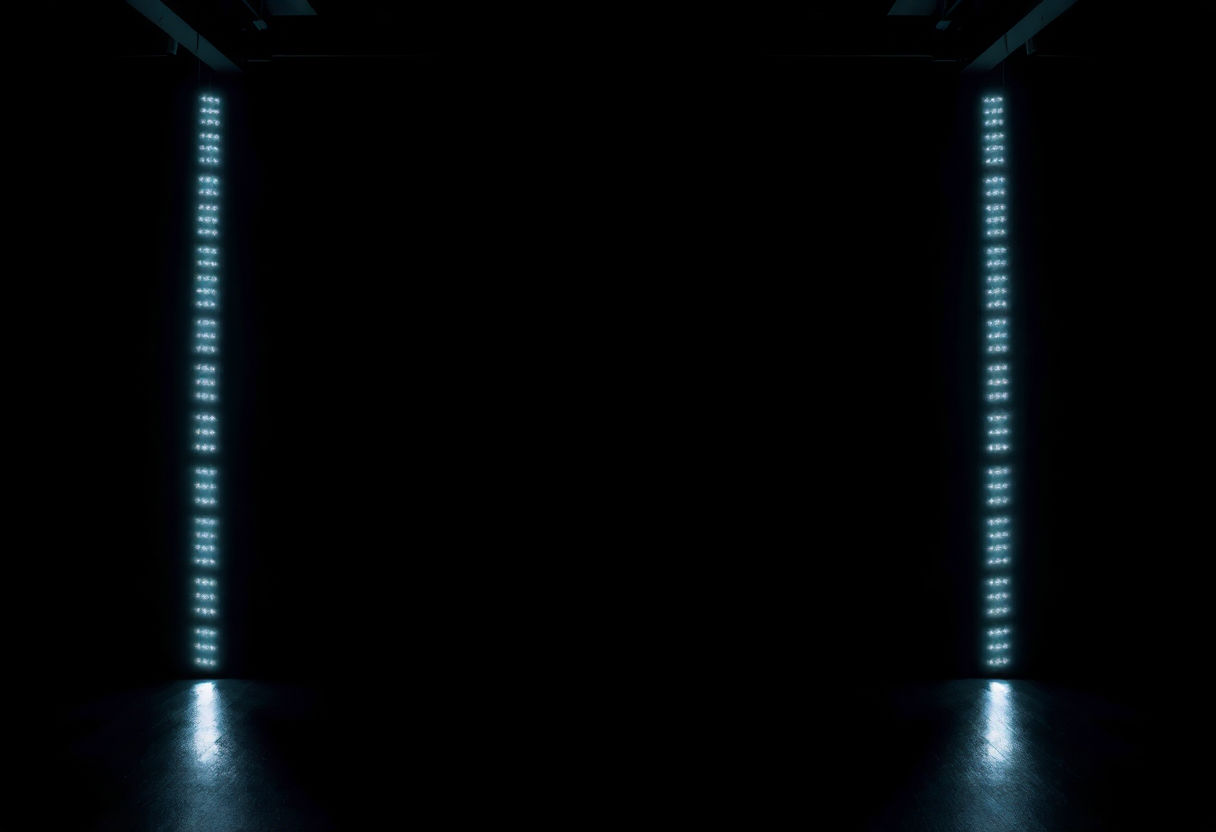
Creating the perfect lighting scheme for a dark-themed apartment is essential to maintain the allure and sophistication of the space. Thoughtful lighting can transform dark areas, highlighting their beauty and ensuring that they remain inviting rather than overwhelming.
Layered Lighting Approach:
To achieve an inviting atmosphere, consider using a layered lighting approach. This entails combining different types of lighting to create depth and warmth. Ambient lighting, such as recessed ceiling lights or wall sconces, provides general illumination. Task lighting, like desk lamps or under-cabinet lights, offers focused light for functional areas, while accent lighting, such as spotlights or LED strips, adds drama by highlighting artwork or architectural features.
Strategic Placement:
The strategic placement of light sources is critical. Positioning lights at varying heights and angles can enhance textures and create visual interest. For instance, placing floor lamps behind seating can create a soft backlight, while pendants can be used to draw attention to specific areas, such as a dining table.
Utilization of Natural Light:
Maximizing natural light is equally vital in a dark space. Use mirrors and reflective surfaces to amplify natural light, distributing it throughout the area. During the day, sheer curtains can be employed to filter sunlight, adding a gentle glow without compromising privacy.
Creative and Artistic Lighting:
For a more artistic touch, consider incorporating statement lighting fixtures. Sculptural chandeliers or modern light installations can serve as focal points, bridging the gap between functionality and art, while ensuring they complement the overall aesthetic of the space.
By thoughtfully selecting and arranging lighting elements, a dark-themed apartment can be both striking and comfortable, providing the perfect backdrop for modern urban living.
Incorporating Textures and Materials
Incorporating diverse textures and materials is crucial in crafting an engaging dark apartment aesthetic. The interplay of different surfaces can add a sense of depth and complexity, which prevents spaces from feeling monotonous or oppressive. For instance, pairing sleek, matte finishes with rougher, tactile elements can create a dynamic contrast that invigorates the senses.
Consider using natural materials, such as wood and stone, which can bring a warm, organic feel to the space. Wood, with its rich grain and warm undertones, can add a soft contrast to dark colors, while stone surfaces offer durability and a timeless appeal. Leather is another excellent choice, especially when used in furniture or as accent pieces, providing a sense of luxury and comfort. The natural patina of leather can soften the visual weight of darker hues.
Metallics can also play a pivotal role in enhancing a dark aesthetic. Incorporating metals like brass, copper, or brushed nickel through fixtures or decorative items introduces reflective qualities that catch light and inject brightness into the room. These accents provide a break from the dominant darker palette, striking a balance between chic sophistication and dramatic allure.
Additionally, textiles such as velvet, silk, or wool can be layered to introduce subtle variances in tone and texture. A plush velvet sofa, for example, becomes a centerpiece, offering both visual interest and tactile pleasure. By thoughtfully combining these elements, one can achieve a richly-textured environment that radiates warmth even in its darkest corners, inviting comfort and contemplation in equal measure.
Balancing with Accents and Decor
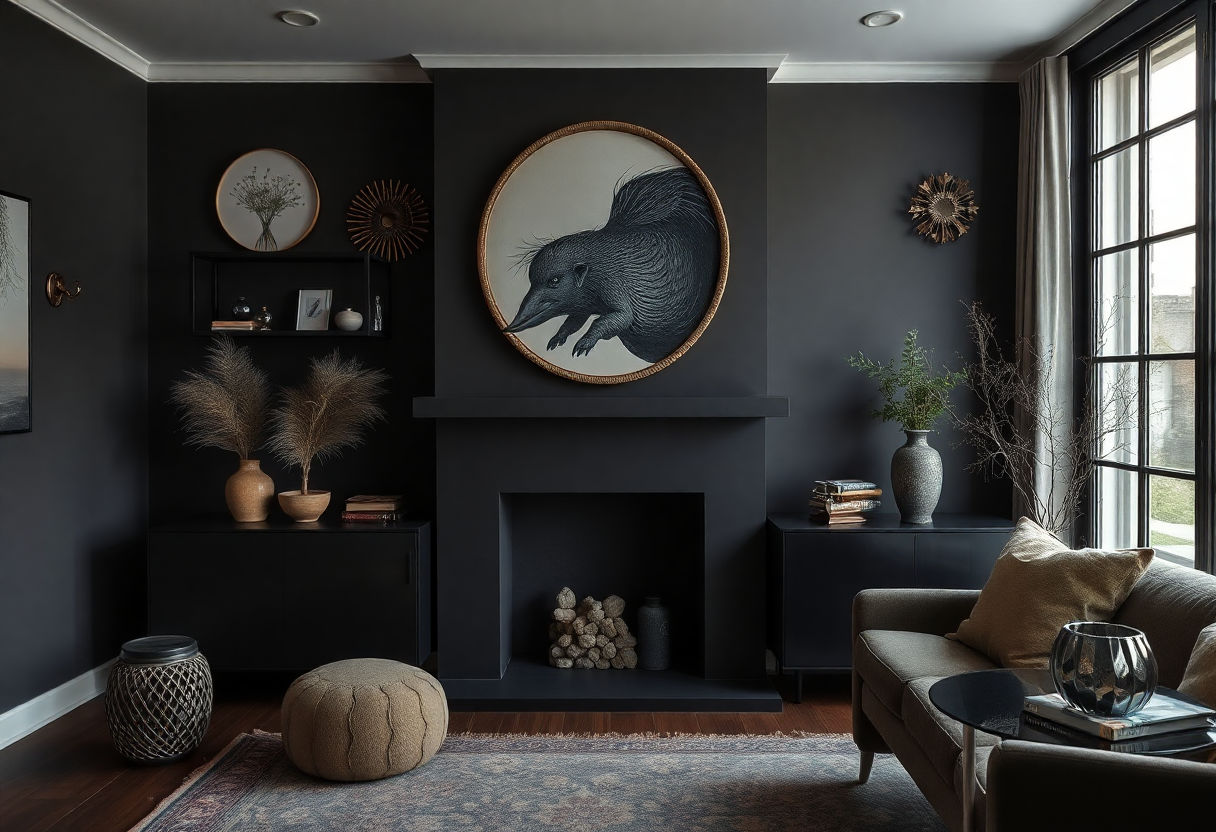
To achieve a sophisticated allure in a dark apartment aesthetic, it is essential to balance the depth of dark hues with strategic accents and decor. Thoughtful accent choices can prevent spaces from feeling overwhelmingly dark and can introduce an element of contrast that highlights the design’s elegance.
When considering accents, one effective approach is to incorporate metallic or reflective surfaces, such as brass, chrome, or polished silver. These elements can act as mirrors that bounce light around the room, enhancing the existing ambient light and adding a touch of opulence.
Artwork is another powerful tool in balancing dark tones. Opt for pieces with rich colors or striking imagery to serve as focal points. Art provides a personalized touch while also injecting vibrancy and interest into the space. Additionally, choosing frames in lighter shades or metallic finishes can further enhance the contrast and draw attention to the art itself.
Plants and natural elements offer an inviting contrast to dark themes. Greenery introduces a liveliness and fresh touch, breaking the monotony of dark surfaces. Consider using plants with bold foliage or placing them in decorative planters that complement the room’s aesthetic.
Finally, fabrics and textiles play a crucial role in creating balance. Layering textiles such as cushions, throw blankets, or rugs in various textures and patterns can soften the room’s look and provide visual and tactile contrast. Selecting lighter shades or complementary colors in these items can subtly balance the dark palette and contribute to a more inviting atmosphere, creating a harmonious, well-rounded aesthetic.
Creating a Cozy Ambience
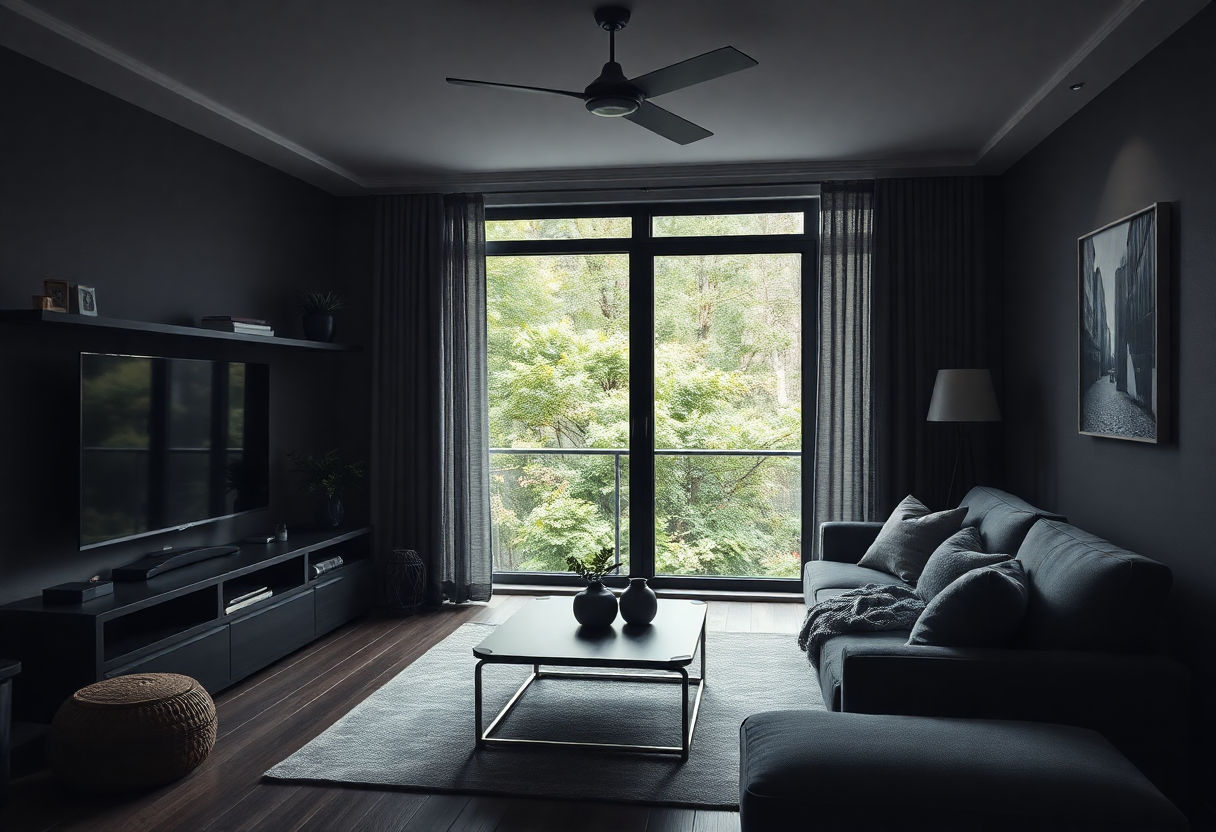
Creating a cozy ambience within a dark-themed apartment involves a delicate blend of elements that evoke a sense of warmth and comfort while maintaining the sophisticated allure of darker aesthetics. One effective method is incorporating soft textiles throughout the space. Plush rugs, velvety throws, and cushioned furnishings can introduce tactile comfort and visual interest, creating a welcoming atmosphere.
Layered lighting plays a pivotal role in achieving coziness. Utilize a combination of ambient, task, and accent lighting to create depth and functionality in rooms. Dimmable lighting fixtures allow for adjusting the brightness according to mood and occasion, ensuring that the space can transform from lively to intimate effortlessly. Warm light bulbs with a yellow hue can soften the edges of dark interiors, generating a gentle glow that makes rooms feel more inviting.
Introducing natural elements like wood, stone, and indoor plants can imbue a sense of balance and harmony. These elements bring in a touch of nature, preventing the space from feeling too stark or cold. Wooden accents, such as coffee tables or shelving, add warmth, while greenery breathes life into the environment, complementing dark tones with their vibrant presence.
Similarly, incorporating artwork and personal items brings character and personalization, crucial for a cozy home environment. Select pieces that resonate emotionally or hold sentimental value. The curatorial aspect of displaying art and cherished objects in a dark apartment not only breaks visual monotony but also weaves personal narratives into the design, making the space truly your own.
Real-Life Examples and Inspirations
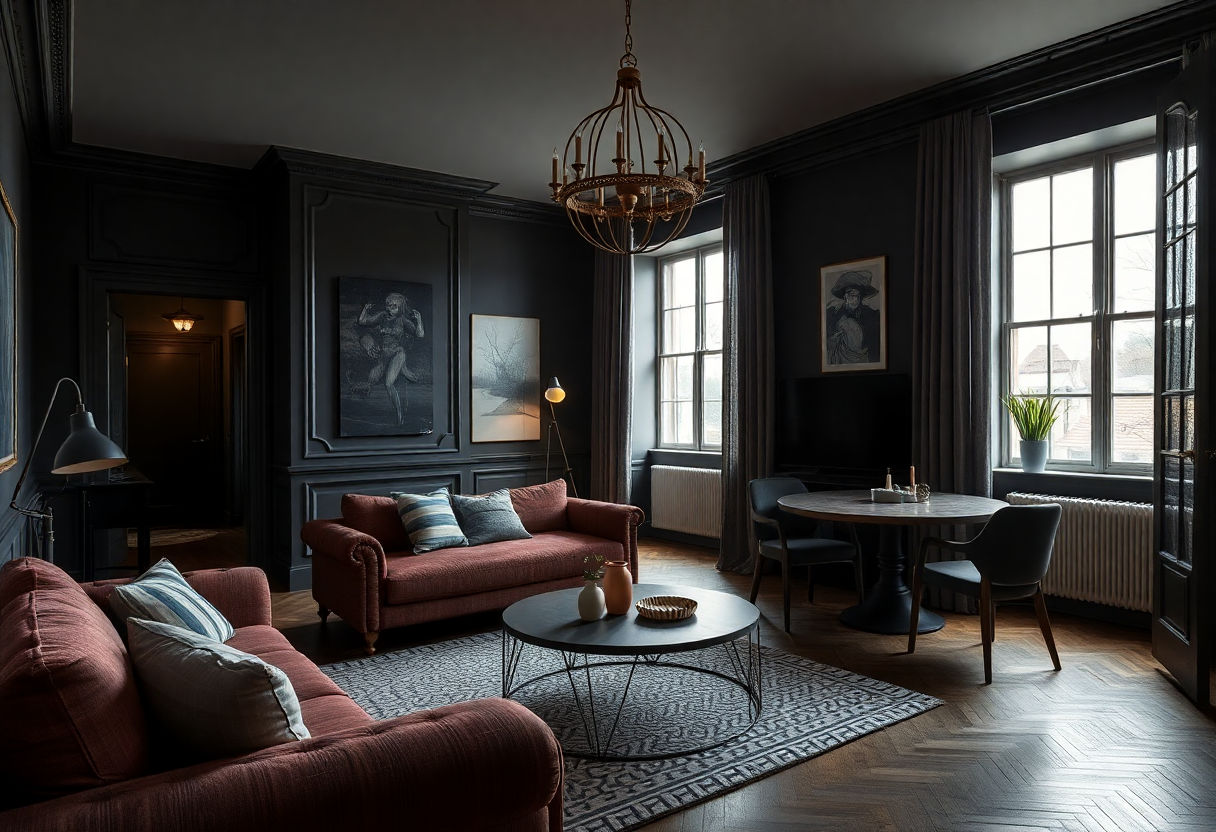
Incorporating a dark apartment aesthetic can transform spaces into stunning works of art. For instance, the urban loft of designer Tom Ford showcases a seamless blend of sleek black furnishings and matte charcoal walls, demonstrating how dark hues can exude luxury and sophistication. This design is further elevated by strategically placed metallic and glass accents, which deliver a subtle contrast and reflect natural light.
Another compelling example is the modern take by New York-based interior decorator Kelly Wearstler, whose design philosophy embraces moody palettes paired with lush textures. Her work often features rich velvets and deep mahogany wood, creating a space that feels both opulent and inviting. Her use of layered lighting — including soft-glow sconces and ambient floor lamps — illustrates how varied lighting can prevent dark spaces from feeling oppressive.
A compelling showcase of dark aesthetics can be found in the Scandinavian-inspired apartment of artist Sofia Jacobsen, where deep teal paints work harmoniously with dark oak floors. Jacobsen pairs her dark color palette with vibrant, abstract art pieces, demonstrating a daring balance between depth and vibrancy. This juxtaposition not only draws attention but also enlivens the space, offering a fresh perspective on dark design.
These examples reflect a trend where dark interiors are not solely about color but about creating a visual story that melds modern elegance with personal style. Whether integrating unique art or using contrasting textures, these real-life inspirations prove that with thoughtful planning, dark aesthetics can transform any space into an enchanting and personalized retreat.
Conclusion
Dark apartment aesthetics offer a captivating blend of sophistication and comfort, making them an enticing choice for modern urban living. By thoughtfully selecting color palettes, furniture, and lighting, one can transform any space into a stylish sanctuary. As urban environments evolve, the trend towards dark interiors continues to gain momentum, appealing to those who appreciate depth and contrast. Embracing this aesthetic opens a realm of creative possibilities, encouraging you to experiment and personalize your space. With careful planning, the allure of a dark-themed apartment can seamlessly translate into a reflection of elegance and modernity in any home.
Frequently Asked Questions
How can I prevent a dark apartment from feeling too gloomy?
To prevent a dark apartment from feeling gloomy, focus on layering different lighting sources, such as ambient, task, and accent lighting, to illuminate various parts of the space. Additionally, incorporating varied textures and materials can add visual interest and depth to the overall design.
Is a dark apartment aesthetic suitable for small spaces?
Yes, a dark apartment aesthetic can be suitable for small spaces if executed thoughtfully. Use strategic lighting and mirrors to create the illusion of a larger area, and choose furniture that maintains a balanced contrast between lightness and shadow.
What colors work best for a dark apartment aesthetic?
The most effective colors for a dark apartment aesthetic include deep shades like charcoal, navy, and forest green, complemented by metallic accents and lighter neutrals to create contrast and highlight details within the space.
How should I choose accents and decor for a dark-themed apartment?
Select accents and decor that offer contrast, such as metallic finishes or vividly colored pieces, to enhance the depth of dark hues. Consider incorporating artwork or decorative elements that add texture and can serve as focal points within the room.
Does a dark apartment aesthetic require more maintenance?
A dark apartment aesthetic may require regular maintenance to prevent dust and smudges from being more noticeable on dark surfaces. However, consistent cleaning and organization can easily manage this concern, ensuring the space remains inviting and sophisticated.
